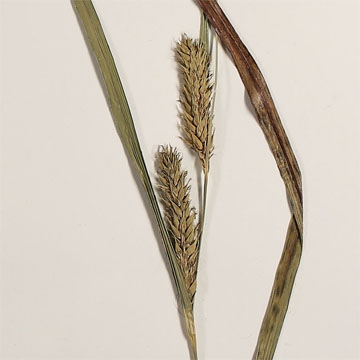

Carex atherodes - (image 1 of 2)
Taxonomy
Family: Cyperaceae
Section Carex (formerly in Paludosae)
Habitat
Marshes, wet-prairies, shores, often in water. Tolerant of deeper water than most Carex.
Associates
Distribution
Circumboreal, south in North America to NY, WV, MO, CO, UT, and OR. More common in the Midwest and West. Rare and local in NY.
Morphology
Perennial from long, coarse, deep-seated rhizomes; stems 30-150 cm, arising singly or few together, aphyllopodic, the lower sheaths soon breaking and becoming fibrillose; sheaths villous-hirsute throughout or sometimes only toward the ventral summit; blades elongate, 4-10 mm, usually hirsute below toward the base, tending to be septate-nodulose; bracts subtending pistillate spikes sheathless or nearly so but with an elongate blade; spikes several, sessile or subsessile, the lower pistillate and the upper staminate, or the middle ones androgynous; staminate spikes 2-6 cm, pale often stramineous, the scales short-awned; pistillate spikes cylindric, 2-10 cm long and 1 cm thick, the scales stramineous or pale greenish and often scarious, narrow, tipped by a rough awn 1-9 mm; perigynia crowded, ascending, pale greenish to stramineous, 12-20 ribbed, glabrous, firm 7-10 mm long, lanceolate or lance-ovate, somewhat turgid-inflated below, more flattened toward the well-developed beak; beak with prominent, often divergent teeth 1.5-2.5(-3) mm long; achene trigonous, loosely filling lower portion of the perigynium, continuous with the straight bony style.
Notes
Fruiting June to August
Wetland indicator: OBL
Can be distinguished from other members of this section by its glabrous perigynia, pubescent sheaths and leaf blades (at least near the base), and relatively long perigynium teeth (1.5-3 mm). Rarely hybridizes with C. trichocarpa which it sometimes grows with.
References
Gleason, Henry A. and A. Cronquist. 1991. Manual of Vascular Plants of
Northeastern United States and Adjacent Canada. Second Ed.
The New York Botanical Garden. Bronx, NY
|
© Michael Hough 2018 |